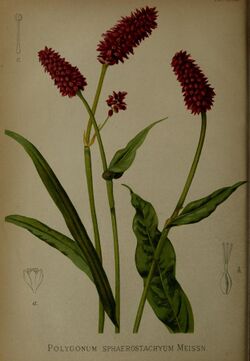Biology:Bistorta macrophylla
| Bistorta macrophylla | |
|---|---|

| |
| Scientific classification | |
| Kingdom: | Plantae |
| Clade: | Tracheophytes |
| Clade: | Angiosperms |
| Clade: | Eudicots |
| Order: | Caryophyllales |
| Family: | Polygonaceae |
| Genus: | Bistorta |
| Species: | B. macrophylla
|
| Binomial name | |
| Bistorta macrophylla (D.Don) Sojak, 1974
| |
| Synonyms | |
| |
Bistorta macrophylla (syn. Polygonum macrophyllum, syn. Persicaria macrophylla) is a flowering plant species in the buckwheat family Polygonaceae.[1] It is native to mountain regions of West and South China (Gansu, Guizhou, Henan, Hubei, Qinghai, Shaanxi, Sichuan, Tibet, Yunnan), Bhutan, Nepal,[2] northern India (Himachal Pradesh, Uttarakhand), and Pakistan.
In Nepal, its rhizomes are dried to be used as food.[3]
In India (Uttarakhand), its leaves are used in traditional medicine to treat wounds.[4] The paste made from the roots is given to infants for stomach problems.[5]
Vernacular names:
- English: red knotweed or large leaved knotweed
- Chinese: 圆穗拳参; pinyin: yuan sui quan shen
- Nepali: Dalle ghans, Dalle jhar[3]
- India: Kukhri,[4] Chhota ninayin, Kande-re-ninai[5]
Compounds (-)-Epicatechin-5-O-beta-D-glucopyranoside, (+)-catechin-7-O-beta-D-glucopyranoside, 1-(3-O-beta-D-glucopyranosyl 4,5-dihydroxy-phenyl)-ethanone, (-)-epicatechin, chlorogenic acid and gallic acid can be found in the species.[6]
References
- ↑ "The Plant List: Bistorta macrophylla (D.Don) Soják". Royal Botanic Gardens, Kew and Missouri Botanic Garden. 2013. http://www.theplantlist.org/tpl1.1/record/kew-2676809.
- ↑ "Polygonum macrophyllum D. Don, Prodr. Fl. Nepal. 70. 1825". Flora of China. http://www.efloras.org/florataxon.aspx?flora_id=2&taxon_id=242339609. Retrieved 17 December 2018.
- ↑ 3.0 3.1 N.K. Bhattarai (1991). "Ethnobotanical studies in Central Nepal: The preservation of plant-foods". Contribution to Nepalese Studies 18 (2): 211–221. http://www.thlib.org/static/reprints/contributions/CNAS_18_02_07.pdf.
- ↑ 4.0 4.1 Phondani, Prakash Chandra (2011). "Worth of Traditional Herbal System of Medicine for Curing Ailments Prevalent Across the Mountain Region of Uttarakhand, India". Journal of Applied Pharmaceutical Science 1 (9): 81–86. http://japsonline.com/abstract.php?article_id=287.
- ↑ 5.0 5.1 K. G. Mukerji; C. Manoharachary (2006). Current Concepts in Botany. I. K. International Pvt Ltd. p. 182. ISBN 978-81-88237-64-7. https://books.google.com/books?id=s87ASB1KpIMC&pg=PA182.
- ↑ Wang, S; Wang, D; Feng, S (2004). ". [Studies on chemical constituents from Polygonum macrophyllum]" (in Chinese). Zhong Yao Cai 27 (6): 411–3. PMID 15524292.
External links
Wikidata ☰ Q3338376 entry
 |

